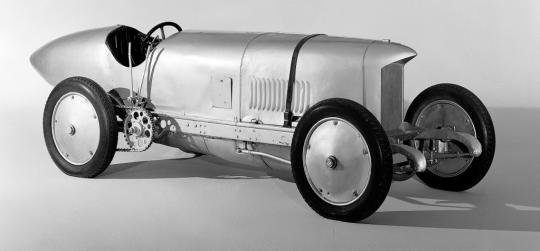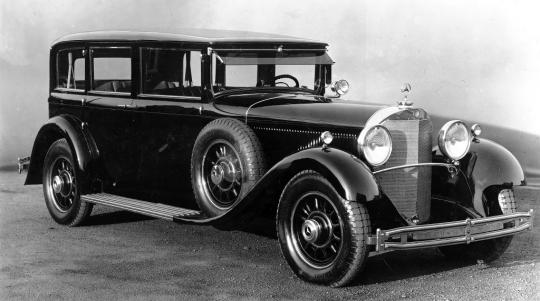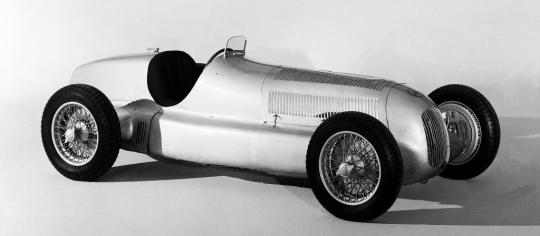
When he grew up, he enrolled as a student at the Technical University of Munich, graduating with a degree in Engineering. Hans started out in employment with various small engineering works, before joining Benz & Cie. in Mannheim as an engineer on March 1, 1904. There, he witnessed and contributed to the company’s rise into one of the world’s leading carmakers.
Nibel was soon promoted to deputy office chief, and in 1908 was appointed the head of the design department, at just 28. Numerous vehicles were created with his participation and under his leadership, including smaller models that placed the company on a broader commercial footing, such as the 6/14 hp Benz introduced in 1910, but also luxury-class vehicles that acted as global ambassadors for the outstanding automobiles from Mannheim.
Another vehicle closely associated with the name Nibel was the Blitzen Benz, the most powerful and fastest car in the world at the time. First unveiled in 1909, it established a new world speed record for a car in 1911, namely 228.1 km/h, a mark that would remain unbeaten until 1919.
Nibel joined the board of management of Benz & Cie. as a deputy member in August 1917, becoming a full member of the board five years later, in the same month. Also in 1922, Nibel worked with Max Wagner, head of the chassis design office in Mannheim, to develop the first streamlined racing cars with individual suspension, an innovation that would soon lead to international racing success.
In addition, he was to prove a significant influence on the use of diesel powerplants in road vehicles – in 1922 Benz & Cie. introduced an agricultural tractor equipped with a self-ignition engine, the world’s first diesel-powered road-going vehicle. That same year, Nibel was awarded an honorary doctorate by the Technical University, Karlsruhe, in recognition for his services as a designer and engineer.Two destinies unite
 When Benz & Cie. and Daimler-Motoren-Gesellschaft formed a community of interests in 1924, Nibel also joined the board of management at DMG. He worked in the same design office and on an equal footing alongside Ferdinand Porsche, although Porsche carried ultimate responsibility.
When Benz & Cie. and Daimler-Motoren-Gesellschaft formed a community of interests in 1924, Nibel also joined the board of management at DMG. He worked in the same design office and on an equal footing alongside Ferdinand Porsche, although Porsche carried ultimate responsibility.
Nibel was a staunch supporter of the merger between the two companies that followed in 1926 – after which he joined the board of management of the new Daimler-Benz AG.
That same year, 1926, he switched his workplace once and for all to the Untertürkheim design office of the new company. As an engineer, but also as a member of the company’s board of management under the leadership of chairman Wilhelm Kissel, Nibel was a key protagonist in the events that brought about the successful merger between the world’s two oldest carmakers.
In the very first day of 1929, Nibel succeeded Ferdinand Porsche as Technical Director. He refined his predecessors’ vehicle designs, his improvements, for example, transforming the success of the 8/38 hp Mercedes-Benz Stuttgart 200 (W 02 series), a car that rewarded the brand during the years of the Great Depression with remarkable unit numbers.
Nibel also improved the sporty S, SS, SSK and SSKL models (W 06) and the elegant Nurburg series (W 08), enabling these vehicles to achieve their full impact – whether on the international sporting scene or in the global luxury car market.
And the first Grand Mercedes 770 model (W 07) anchored Mercedes-Benz in the collective consciousness as the brand that built some of the world’s finest cars – another of Nibel’s achievements, for as chief engineer he always answered for and understood the vehicle in its entirety.
Among the technical innovations of the Grand Mercedes was a light alloy crankcase with cooling fins and a chromium-nickel steel crankshaft mounted on nine bearings and with integrally forged counterweights.
The W 25 racing car, designed by Nibel for the 750-kilogram formula, was another vehicle to cause kind of a stir. With drivers such as Rudolf Caracciola at the wheel, the car brought the company numerous landmark racing successes between 1934 and 1937 – and also launched the tradition of the Silver Arrows. Nibel also left his mark on numerous Daimler-Benz aero engines from the 1930s.Death and legacy
 On November 25, 1934, Hans Nibel was about to board the express for Berlin at the main railway station in Stuttgart, to begin preparations for the 1935 motor racing season. His life was suddenly cut short by a heart attack, robbing the world of one of the most talented engineers of the pre-war era. Daimler-Benz AG lost its chief engineer – but in subsequent years the company was nevertheless able to build on the rich technological legacy that Nibel left behind.
On November 25, 1934, Hans Nibel was about to board the express for Berlin at the main railway station in Stuttgart, to begin preparations for the 1935 motor racing season. His life was suddenly cut short by a heart attack, robbing the world of one of the most talented engineers of the pre-war era. Daimler-Benz AG lost its chief engineer – but in subsequent years the company was nevertheless able to build on the rich technological legacy that Nibel left behind.
The vehicles in which Hans Nibel had a hand influenced the positive image of the Mercedes-Benz brand for many years, both before and after his death. Many of his designs remained relevant until well after the Second World War. As such, he can be regarded as one of the most influential automotive engineers, not just of Mercedes-Benz, but of the automotive industry as a whole.








